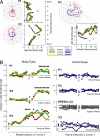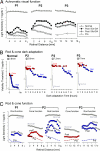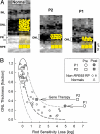Human gene therapy for RPE65 isomerase deficiency activates the retinoid cycle of vision but with slow rod kinetics
- PMID: 18809924
- PMCID: PMC2567501
- DOI: 10.1073/pnas.0807027105
Human gene therapy for RPE65 isomerase deficiency activates the retinoid cycle of vision but with slow rod kinetics
Abstract
The RPE65 gene encodes the isomerase of the retinoid cycle, the enzymatic pathway that underlies mammalian vision. Mutations in RPE65 disrupt the retinoid cycle and cause a congenital human blindness known as Leber congenital amaurosis (LCA). We used adeno-associated virus-2-based RPE65 gene replacement therapy to treat three young adults with RPE65-LCA and measured their vision before and up to 90 days after the intervention. All three patients showed a statistically significant increase in visual sensitivity at 30 days after treatment localized to retinal areas that had received the vector. There were no changes in the effect between 30 and 90 days. Both cone- and rod-photoreceptor-based vision could be demonstrated in treated areas. For cones, there were increases of up to 1.7 log units (i.e., 50 fold); and for rods, there were gains of up to 4.8 log units (i.e., 63,000 fold). To assess what fraction of full vision potential was restored by gene therapy, we related the degree of light sensitivity to the level of remaining photoreceptors within the treatment area. We found that the intervention could overcome nearly all of the loss of light sensitivity resulting from the biochemical blockade. However, this reconstituted retinoid cycle was not completely normal. Resensitization kinetics of the newly treated rods were remarkably slow and required 8 h or more for the attainment of full sensitivity, compared with <1 h in normal eyes. Cone-sensitivity recovery time was rapid. These results demonstrate dramatic, albeit imperfect, recovery of rod- and cone-photoreceptor-based vision after RPE65 gene therapy.
Conflict of interest statement
Conflict of interest statement: B.J.B., W.W.H., and the University of Florida have a financial interest in the use of AAV therapies and own equity in a company (AGTC Inc.) that might, in the future, commercialize some aspects of this work. J.M.W. is an inventor on patents related to gene therapy that have been licensed to a number of biopharmaceutical companies. University of Pennsylvania, University of Florida, and Cornell University hold a patent on the described gene therapy technology (United States Patent 20070077228, “Method for Treating or Retarding the Development of Blindness”).
Figures




References
Publication types
MeSH terms
Substances
Grants and funding
LinkOut - more resources
Full Text Sources
Other Literature Sources
Medical
Research Materials

